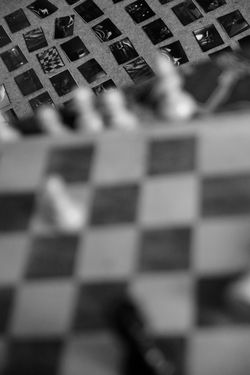Pauline P. Raybaud
Le Je d'Echec
Le Je d'échec is a psycho-dramatic film about being, time, and acceptation.
On her own but not alone, a woman sets her play on the oneiric stages of a story she composes. Locking herself in a retired manor, she builds up characters and frames her voice, creating a mental game in search for expression, embracing characters from one set to the next, dispatching pawns on an infinite board as she expresses her different selves.
It’s a play to find her voice, an insight of the internal thoughts of a mind that can’t place itself no where, a fight with the expression of a troubled identity that needs enclosure to comprehend her multitude. External sounds come back hitting the window, but the frame stays closed. She locks herself in the deepest of her demons in order to comprehend them. Far from the crowd she recreates her dichotomy, through a human scale play where she can embody her personas, where all her characters can be framed, used, expressed, falling one by one until the final queen stands still, on her own but not alone, protecting the last dying character. It’s a mental composition trying to unlock her most profound reality, where the performance becomes a key for expression, for what can’t be comprehended verbally.
Stills - Le Je d'Echec
Co-directed by P. Raybaud and P. Amougou
January 2019
Trailer - Le Je d'Echec
Co-directed and Edited by
P. Raybaud and P. Amougou
Director of photography P. Amougou
Script and interpretation by P. Raybaud
January 2019
The game of chess becomes the metaphor of her inner duality, the never ending of possibilities, yet unfolding through a defined pattern. Pawns fall as she gives up on some of her voices, tries on different masks both physically and mentally, uses languages as tools for various thoughts, plays with narration and time as she wonders through the house, from one room to the next, yet descending a defined line down an infinite staircase to meet what she can’t escape. Her duality. She discovers acceptance on the stages she creates, allowing her inner voice to speak in multiple, to finally hear in peace the echo of her doubled voice. But the dream may be short and reality may hit back. Once the window is open and the sound of the street comes back, she will be faced for one more time with the reality of her not always listening to that voice, of her still struggling to accept her multiple identity (bipolarity?), still letting the train pass, by fear of being her.

The use of sensorial and intellectual mechanism is rhyming the protagonist’s journey. In this project, I am looking into associations between the seeing-sensing, taking the viewer on the same path as the woman they are looking at, through. In this introspective movie where being is at the heart of questioning, the watcher is asked to renew his sight, to become a voyeur, opening step-by-step his eyes to this acceptance, as the image of it appears more and more to the protagonist.
Photograph of the pattern for the editing montage.
To echo this back and forth of her conscience on its path to clarity, colours became a mirror of her hesitations, and in the movie lays a physical play with a chest deck responding to a metaphorical swift between clair and obscure shots and to the sound of falling pawns.
The chess pattern is also used in editing of the narrative montage, that is composed on the linguistic play on words and french/english back and forth of the protagonist's inner dialogue, mirroring her inner doubts in the phrasing of her identity.




